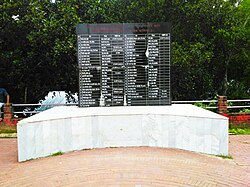Kasba Upazila
Kasba upazila
কসবা | |
|---|---|
 Martyrs Memorial at Kullapathar | |
 | |
| Coordinates: 23°44′N 91°10′E / 23.733°N 91.167°E | |
| Country | |
| Division | Chittagong |
| District | Brahmanbaria |
| Area | |
• Total | 209.77 km2 (80.99 sq mi) |
| • Urban | 16.86 km2 (6.51 sq mi) |
| Population | |
• Total | 357,961 |
| • Density | 1,700/km2 (4,400/sq mi) |
| • Urban | 40,416 |
| Time zone | UTC+6 (BST) |
| Postal code | 3460[3] |
| Area code | 08524[4] |
| Website | kasba |
Kasba (Bengali: কসবা) is an upazila of Brahmanbaria District, Chittagong Division in east-central Bangladesh. It is located approximately 150 km north of Chittagong[5] and was part of greater Comilla District until 1984.[6]
History
[edit]Present-day Kasba was formerly known as Kailagarh, which was said to have been a corruption of Qilagarh wherein qila referred to an army cantonment and garh referred to a fort. The area was later renamed Kasba, a common place name that is used in the Muslim world to refer to a medina quarter or citadel.
Geography
[edit]Kasba is located in southeast Brahmanbaria District. It has a total area of 209.77 km2 (80.99 sq mi). It is bordered by Akhaura Upazila, Brahmanbaria Sadar Upazila and Nabinagar Upazila to the north, Brahmanpara Upazila to the south, Tripura State of India to the east, and Nabinagar, Muradnagar and Brahmanpara Upazilas of Comilla district to the west. The geography of the upazila is characterized by low-lying land with small hills and hillocks of red soil.
Demographics
[edit]According to the 2011 Census of Bangladesh, Kasba Upazila had 60,919 households and a population of 319,221. 89,894 (28.16%) were under 10 years of age. Kasba had a literacy rate (age 7 and over) of 50.68%, compared to the national average of 51.8%, and a sex ratio of 1102 females per 1000 males. 40,416 (12.66%) lived in urban areas.[1]
According to the 1991 Bangladesh census, Kasba had a population of 243833. Males constituted 50.69% of the population, and females 49.31%. The majority of the population was Muslim (94.59%), with Hindus at 5.40% and others at 0.01%. The population aged 18 or over was 112,611. Kasba had an average literacy rate of 30.7% (7+ years), compared to the national average of 32.4%.[8]
Administration
[edit]The administration for Kasba was founded in 1908 as a police station and upgraded to an upazila (Sub-District) in 1983.
Kasba Upazila is divided into Kasba Municipality and ten union parishads: Badair, Benauty, Bayek, Gopinathpur, Kasba Paschim, Kayempur, Kharera, Kuti, Mehari, and Mulagram. The union parishads are subdivided into 136 mauzas and 209 villages.[1]
Kasba Municipality is subdivided into 9 wards and 34 mahallas.[1]
The chairman of Kasba Upazila Parishad is advocate Rashedul Kawser Bhuiyan Jibon.[9]
National Assembly (parliament) seat no. 246-Brahmanbaria-4 (Current MP, Advocate Anisul Haq, Minister of Law).
Education
[edit]There are eight colleges in the upazila.[9] They include Adarsha Degree College, Chargas N.I. Bhuyan Degree College, Gopinathpur Al-Haj Shah Alam College, Kalsher Nayeema Alam Mohila College, Kasba Mohila Degree College, Kasba T. Ali Degree College, and Mia Abdullah Wazed Women's Degree College.[10][11]
According to Banglapedia, Jamsherpur High School, founded in 1923, Kasba Government High School (1899), Kheora Anandamayee High School (1975), and Kuti Atal Bihari High School (1918),Chandidwar High School(1948) are notable secondary schools.[9]
There are many Primary & K.G School in kasba upazilla including Majlishpur Govt. Primary School & Sunmoon Kinder Garten. The madrasa education system includes one fazil madrasa. It is Purquil Gausiya Habibiya Fazil Madrasa.[12]
Notable people
[edit]- Anisul Huq, Law Minister of Bangladesh
- Hasnat Abdul Hye, writer and novelist
- Muhammed Abul Manzur, military officer
- Serajul Huq, politician
- Tafazzal Ali , politician ,
- Liaquat Ali , politician
See also
[edit]References
[edit]- ^ a b c d "Bangladesh Population and Housing Census 2011 Zila Report – Brahmanbaria" (PDF). bbs.gov.bd. Bangladesh Bureau of Statistics.
- ^ National Report (PDF). Population and Housing Census 2022. Vol. 1. Dhaka: Bangladesh Bureau of Statistics. November 2023. p. 396. ISBN 978-9844752016.
- ^ "Bangladesh Postal Code". Dhaka: Bangladesh Postal Department under the Department of Posts and Telecommunications of the Ministry of Posts, Telecommunications and Information Technology of the People's Republic of Bangladesh. 20 October 2024.
- ^ "Bangladesh Area Code". China: Chahaoba.com. 18 October 2024.
- ^ Kumar, Gautam Bera (2010). The Land of Fourteen Gods: Ethno-cultural Profile of Tripura. Mittal Publications. pp. 46–. ISBN 978-81-8324-333-9. Retrieved October 7, 2012.
- ^ Musa, Muhammad. Brahmanbariar Itibrittyo, Shetu Prokashoni, Brahmanbaria, 1998.
- ^ Population and Housing Census 2022 - District Report: Brahmanbaria (PDF). District Series. Dhaka: Bangladesh Bureau of Statistics. June 2024. ISBN 978-984-475-275-7.
- ^ "Population Census Wing, BBS". Archived from the original on 2005-03-27. Retrieved November 10, 2006.
- ^ a b c Chowdhury, Md Abu Russel (2012). "Kasba Upazila". In Islam, Sirajul; Jamal, Ahmed A. (eds.). Banglapedia: National Encyclopedia of Bangladesh (Second ed.). Asiatic Society of Bangladesh.
- ^ "List of Degree Colleges (Honors)". Ministry of Education. Retrieved June 17, 2017.
- ^ "List of Degree Colleges (Pass)". Ministry of Education. Retrieved June 17, 2017.
- ^ "List of Fazil Madrasas". Ministry of Education. Retrieved June 17, 2017.

